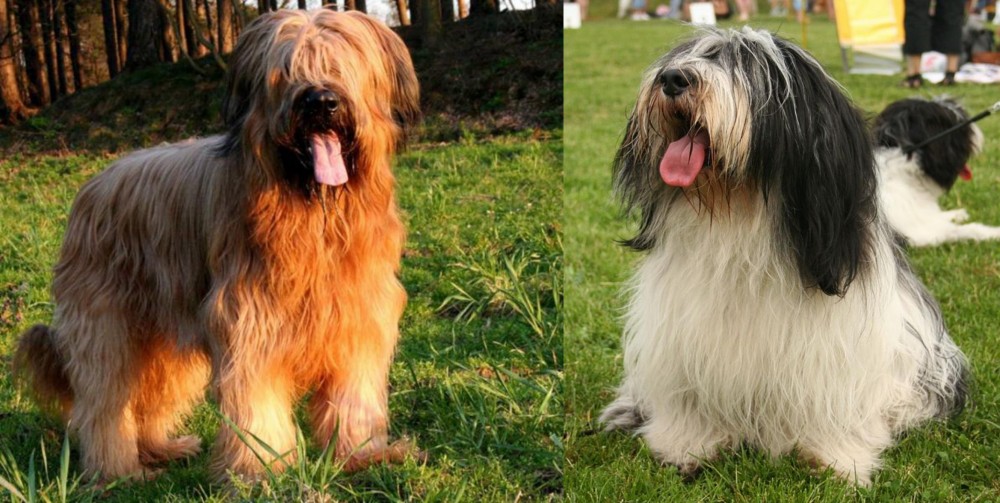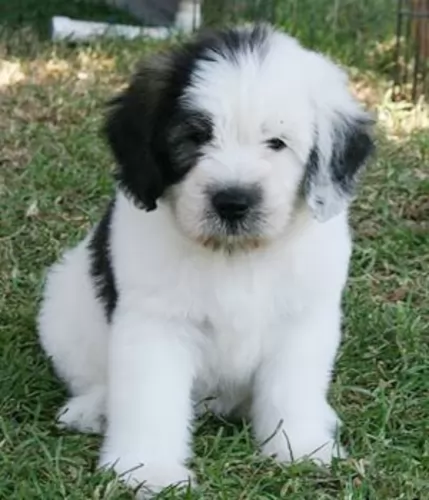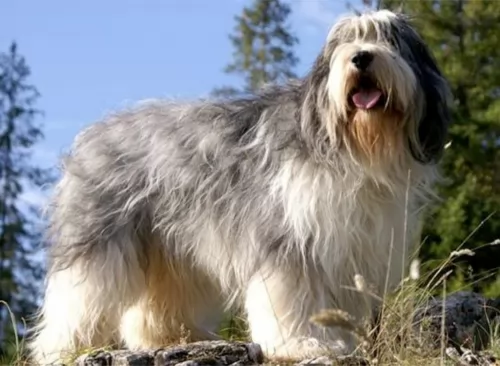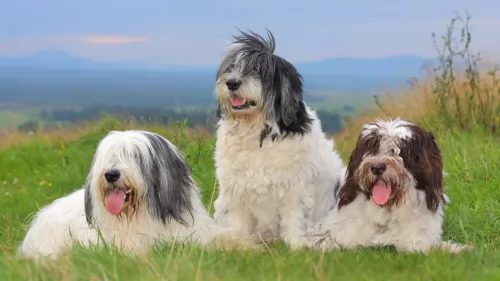 Petzlover
Petzlover Briard is originated from France but Polish Lowland Sheepdog is originated from Poland. Briard may grow 19 cm / 8 inches higher than Polish Lowland Sheepdog. Briard may weigh 17 kg / 38 pounds more than Polish Lowland Sheepdog. Briard may live 3 years less than Polish Lowland Sheepdog. Both Briard and Polish Lowland Sheepdog has almost same litter size. Briard requires High Maintenance. But Polish Lowland Sheepdog requires Moderate Maintenance
Briard is originated from France but Polish Lowland Sheepdog is originated from Poland. Briard may grow 19 cm / 8 inches higher than Polish Lowland Sheepdog. Briard may weigh 17 kg / 38 pounds more than Polish Lowland Sheepdog. Briard may live 3 years less than Polish Lowland Sheepdog. Both Briard and Polish Lowland Sheepdog has almost same litter size. Briard requires High Maintenance. But Polish Lowland Sheepdog requires Moderate Maintenance
 Through myth and legend, the Briard is thought to be a very ancient dog. A French herding breed, a Briard type of dog appears in writings as early as the end of the 14th century. According to legends the Briard was owned by Napoleon, Charlemagne, Lafayette and Thomas Jefferson. As a cross between the Barbet and the Beauceron, the Briard came into popularity following its appearance in a Paris dog show in 1863. Bred originally to guard and herd sheep, these intelligent, independent dogs were often left on their own. Because they both guarded and herded, their size and structure as well as their personalities were different from other dogs that worked sheep. Those that herded only were fast, agile and smaller. Those that only guarded were heavier, bigger and stronger. The Briard was in-between these two types of breeds. He was well suited to any kind of farm work and guarded the crops from the sheep’s desire to eat them. They moved the sheep from one grazing area to another and then to their holding area at night. No humans had to assist the Briard in this work once they were trained.
Through myth and legend, the Briard is thought to be a very ancient dog. A French herding breed, a Briard type of dog appears in writings as early as the end of the 14th century. According to legends the Briard was owned by Napoleon, Charlemagne, Lafayette and Thomas Jefferson. As a cross between the Barbet and the Beauceron, the Briard came into popularity following its appearance in a Paris dog show in 1863. Bred originally to guard and herd sheep, these intelligent, independent dogs were often left on their own. Because they both guarded and herded, their size and structure as well as their personalities were different from other dogs that worked sheep. Those that herded only were fast, agile and smaller. Those that only guarded were heavier, bigger and stronger. The Briard was in-between these two types of breeds. He was well suited to any kind of farm work and guarded the crops from the sheep’s desire to eat them. They moved the sheep from one grazing area to another and then to their holding area at night. No humans had to assist the Briard in this work once they were trained.
During World War 1, the Briards were drafted into service as messengers, sentries and search dogs for lost or injured soldiers. In that time frame the breed served almost to the point of extinction. Breeding programs following the war brought them back. Today the Briard is a home companion, a police dog, as well as both military and civilian search and rescue dogs.
 Hailing from Poland, the Polish Lowland Sheepdog is believed to have descended from herding dogs as well as the Puli and Tibetan Terrier.
Hailing from Poland, the Polish Lowland Sheepdog is believed to have descended from herding dogs as well as the Puli and Tibetan Terrier.
Later these dogs were bred with local Scottish dogs to bring about Scottish herding dogs, the Bearded Collie. The dog was accepted by the Federation Cynologique Internationale in 1959. In 2001, the American Kennel Club recognized the Polish Lowland Sheepdog as a breed in the Herding Group.
 The Briard is a powerful, intelligent and independent working dog. They have a straight topline and their height is almost the same as their length. They have long, large, rectangular heads with wide muzzles. Their noses are also square and jet black while their side set, large eyes can be black-brown or black. Their ears have traditionally been cropped but with more countries outlawing it, they can now have natural ears set high on the head. They have a tail that is feathered and low-cut. The feet of a Briard are round, compact and large.
The Briard is a powerful, intelligent and independent working dog. They have a straight topline and their height is almost the same as their length. They have long, large, rectangular heads with wide muzzles. Their noses are also square and jet black while their side set, large eyes can be black-brown or black. Their ears have traditionally been cropped but with more countries outlawing it, they can now have natural ears set high on the head. They have a tail that is feathered and low-cut. The feet of a Briard are round, compact and large.
The Briard is a double coated breed with a long beard and mustache. Their hair completely covers the head and the eyes so that they are not seen. They have prominent eyebrows as well.
 The Polish Lowland Sheepdog is a medium-sized dog. Both males and females stand between 42cm to 50 cm in height and they weigh roughly between 14 and 23kg.
The Polish Lowland Sheepdog is a medium-sized dog. Both males and females stand between 42cm to 50 cm in height and they weigh roughly between 14 and 23kg.
The dog has a double coat which can mostly be white, cream, gray, brown and black. The underdoat is soft and dense with the top coat being straight or wavy and being medium length.
There is quite a bit of hair around the facial area. The eyes are alert and brown and the ears medium size, high set and then drooping down. The tail has always been attractively docked, giving the dog an attractive, compact look but these days it is often just left long.
Lively, bright as a button, clever, social and feisty, the Polish Lowland Sheepdog is easy to train, becoming obedient and well balanced. The Polish Lowland Sheepdog is such a self confident dog and he will fit happily into life in the city or the countryside, loving spending time with his human family.
 As mentioned previously the Briard is intelligent and independent. They are also loyal, rugged, protective and bond intensely with their humans. They are often aloof when it comes to strangers or even when new furniture is introduced into the household. They have to learn that anything new into the family environment is friendly and good. They are great with children and susceptible to separation anxiety because of their deep affection for their people. Socialization for puppies is a must. This will let them know that people and children, other dogs in general are not harmful to their families. They have great memories and once they learn something – right or wrong – it is almost impossible to change it. They were bred to be independent thinkers who acted on their own conclusions. This is still true of the breed today, making them appear to be stubborn.
As mentioned previously the Briard is intelligent and independent. They are also loyal, rugged, protective and bond intensely with their humans. They are often aloof when it comes to strangers or even when new furniture is introduced into the household. They have to learn that anything new into the family environment is friendly and good. They are great with children and susceptible to separation anxiety because of their deep affection for their people. Socialization for puppies is a must. This will let them know that people and children, other dogs in general are not harmful to their families. They have great memories and once they learn something – right or wrong – it is almost impossible to change it. They were bred to be independent thinkers who acted on their own conclusions. This is still true of the breed today, making them appear to be stubborn.
They are great watchdogs, fearless and brave; willing to learn, eager to make you happy. They are basically gentle but that always runs up against their protective nature. A strong alpha leader is needed to handle this hard-working dog.
 The PON is an independent, self-willed dog but he can also be entertaining and amusing. He is a social, friendly dog but for many people, his long hair and grooming requirement might prove to be a bit of a handful.
The PON is an independent, self-willed dog but he can also be entertaining and amusing. He is a social, friendly dog but for many people, his long hair and grooming requirement might prove to be a bit of a handful.
Your dog is energetic, cheerful and playful and when he isn’t around, it will be like some sunshine has gone out of your life. He is faithful and loving towards his human family but is aloof towards strangers. Bring one of these dogs into your home and you’re guaranteed to have a remarkable friend and pet for many years.
 Being a large breed, the Briard shares many of the same health concerns as other large breeds. They have a few of their own as well. Typical issues for a Briard might include:
Being a large breed, the Briard shares many of the same health concerns as other large breeds. They have a few of their own as well. Typical issues for a Briard might include:
Progressive Retinal Atrophy/Degeneration –degeneration of the photoreceptors and retina.
 These dogs are generally healthy and the dog’s life expectancy is about 12 years. Nonetheless there are some problems to be aware of. For instance, with this dog, hip dysplasia is a real problem.
These dogs are generally healthy and the dog’s life expectancy is about 12 years. Nonetheless there are some problems to be aware of. For instance, with this dog, hip dysplasia is a real problem.
The Orthopedic Foundation of America evaluated the hip X-rays of hundreds of these dogs and found a large percentage were dysplastic.
Hereditary eye disease can also occur with this dog. Macular degeneration is a common eye disorder that can cause central vision loss. Many genetic abnormalities can cause degeneration of the image forming part of the eye. Unfortunately these conditions can result in total blindness. Parts of the retina can also degenerate with age.
Skin allergies are also an ever present threat with your dog. Itchiness and pain can be a nightmare for your pet and scratching and licking brings no relief – just aggravates the condition. You will certainly need to get your pet to the vet as skin allergies and skin diseases can make your beloved canine miserable.
 It is best to feed the Briard smaller meals 2-3 times a day to prevent bloat. Feed 3-4 cups total for the day of a dry dog food that is high quality and made for large breeds.
It is best to feed the Briard smaller meals 2-3 times a day to prevent bloat. Feed 3-4 cups total for the day of a dry dog food that is high quality and made for large breeds.
Stationary Night Blindness – Congenital limited vision in the dark can vary from slight difficulty moving to complete inability to see in the dark.
Progressive Retinal Atrophy/Degeneration – Can lead to night blindness, limited or total blindness. Puppies with the disease can be blind before their first birthday.
Bloat (Gastric Torsion) – Stomach is distended and twists. Fatal if not treated quickly. Caused by eating a large meal quickly and either exercise immediately or drink a large amount of water right after eating.
Von Willebrand’s Disease – Blood clotting disorder leads to excessive bleeding. There is no cure, but it is manageable.
The Briard is a working dog and as such needs a job. They excel at agility, flyball, herding, obedience, confirmation and tracking. They need exercise and make excellent service dogs for people with disabilities and therapy dogs for those in emotional need.
 Your Polish Lowland Sheepdog is like a big Bear and his long, shaggy coat will require regular brushing, otherwise it could become full of burrs and grass.
Your Polish Lowland Sheepdog is like a big Bear and his long, shaggy coat will require regular brushing, otherwise it could become full of burrs and grass.
Many people prefer to take their dogs to a grooming parlor where the hair is cut, the nails trimmed, the teeth cleaned and the ears checked.
Provide your Sheepdog with a nice warm, dry cozy spot that is his and where he can quietly retreat.
If your Polish Lowland Sheepdog spends time outdoors, make sure he has access to both shade, sun and shelter in case it rains. There must always be a bowl of fresh water outdoors too.
It is better to give your adult Polish Lowland Sheepdog 2 smaller helpings of food as opposed to one big bowl. Puppies will need 4 bowls of food a day. Two bowls will ensure your dog doesn’t gobble up his food and create digestive problems and bloat.
High-quality dry dog food will provide a balanced diet, but you want to make it a little more delicious for him occasionally by mixing in chopped up boiled chicken, brown rice, sweet potatoes, carrots and spinach. Just a tad of raw meat occasionally can also be of huge benefit.
Fresh, cool water should always be available around the clock. Be sure to keep his food and water dishes clean.
Have your dogs spayed or neutered if you don’t want them to have puppies.